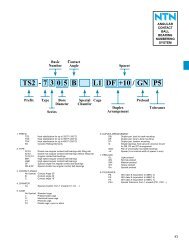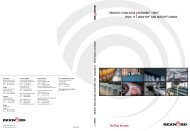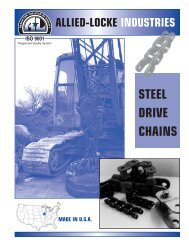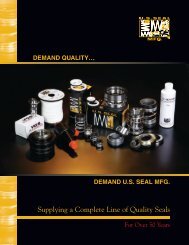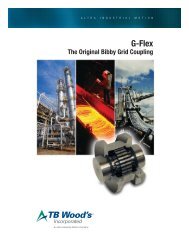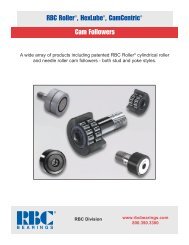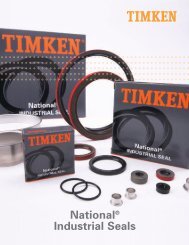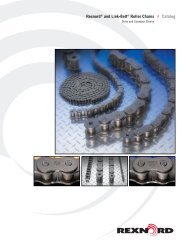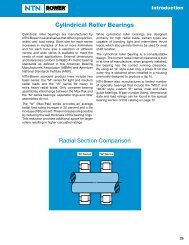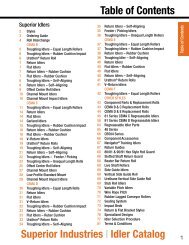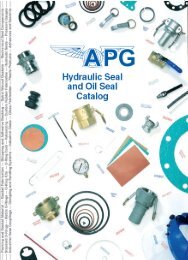Selection Procedures1. Determine HP/100RPM: HP/100 RPM = Horsepower x 100RPM2. Determine Service Factor:Select the proper Service Factor from Table on page13. If not listed, see Load Classification Table.Remember to consider both driver and drivenequipment and temperature requirements.3. Multiply HP/100 by the service factor to get equivalent HP/100 RPM.4. Select the Coupling Size:From Table 1, with a rating equal to or greater than theequivalent HP/100 RPM determined in Step 3.5. Check Limiting Conditions:Be sure that the operating speed of the coupling doesnot exceed maximum RPM listed on page 4-7.6. Select Desired Hub Type:Select desired hub type and check maximumallowable coupling bore on page 14.OR1. Determine Operating Torque:( 63,000 x HP RPM )2. Multiply by Service FactorSelect the proper Service Factor from Table on page 13.3. Select the Coupling Size:Select coupling size from Table 2 with a capacityequal to or greater than determined in Step 2.4. Follow Steps 5 & 6 AboveTable 1SizeEquivalentStandard Spacer HP/100 RPME2 ES2 0.3E3 ES3 0.58E4 ES4 0.88E5 ES5 1.48E10 ES10 2.3E20 ES20 3.65E30 ES30 5.79E40 ES40 8.85E50 ES50 12.14E60 ES60 19.84E70 ES70 35.12E80 ES80 62.7E100 NA 135E120 NA 270E140 NA 540Table 2Torque CapacitySizeContinuousTorque(In. Lbs.)SizeContinuousTorque(In. Lbs.)2 190 40 5,5003 365 50 7,6504 550 60 12,5005 925 70 22,12510 1,450 80 39,50020 2,300 100 85,05030 3,650 120 170,100140 340,200Service FactorsService Factors are a means of classifying different equipment and applications into various load classifications.Due to variations in application of equipment, service factors are used to adjust equipment ratings to accommodatefor variable loading conditions. This is a general guide. More specific factors are given on page 13.Load ClassificationsService FactorsContinuous service and running loads vary only slightly. 1.0Torque loading varies during operation of the equipment. 1.5Torque loading varies during operation, frequent stop/2.0start cycles are encountered.<strong>Omega</strong> ® ElementTemperature Range (Ambient)-40°F+200°Fto-40°C+93°CHigh TemperatureService Factor Adjustment*Ambient Temp. S.F. Adjust.+150°F (66°C) 0.025+165°F (74°C) 0.05+180°F (82°C) 0.75+200°F (93°C) 1*Added to application service factorFor shock loading and substantial torque variations. 2.5For heavy shock loading or light reversing drives. 3.0Reversing torque loads do not necessarily mean reversalof rotation. Depending upon severity of torque reversal,Consult <strong>Rex</strong>nordsuch loads must be classified between “medium” and“extreme.”The service factor adjustmentfor high temperature is inaddition to the service factorconsideration for the driver anddriven equipment. However, ifhigh temperatures are typical fora specific application, maximumtemperature consideration isincorporated into the “typical”service factor listing on page 13.i.e., steel mill runout tables.12
13Typical Service Factors – Motor And Turbine Driven Equipment AGITATORSVertical and Horizontal Screw Propeller, Paddle . . . . . . . . . . . . . . . . . . . . . . . 1.5BLOWERSCentrifugal . . . . . . . . . . . . . . . . . . . . . . . . . . . . . . . . . . . . . . . . . . . . . . . . . . . . 1.0Lobe or Vane . . . . . . . . . . . . . . . . . . . . . . . . . . . . . . . . . . . . . . . . . . . . . . . . . . 1.5CAR DUMPER AND PULLER. . . . . . . . . . . . . . . . . . . . . . . . . . . . . . . . . . . . . . . 2.0COMPRESSORSCentrifugal . . . . . . . . . . . . . . . . . . . . . . . . . . . . . . . . . . . . . . . . . . . . . . . . . . . . 1.0Rotary, Lobe, or Vane . . . . . . . . . . . . . . . . . . . . . . . . . . . . . . . . . . . . . . . . . . . 2.0Rotary, Screw. . . . . . . . . . . . . . . . . . . . . . . . . . . . . . . . . . . . . . . . . . . . . . . . . 1.25Reciprocating . . . . . . . . . . . . . . . . . . . . . . . . . . . . . . . . . . . . . . . . . . . . . . . . . . . ÁCONVEYORSApron, Assembly, Belt, Chain, Flight, Oven . . . . . . . . . . . . . . . . . . . . . . . . . . . 1.5Reciprocating . . . . . . . . . . . . . . . . . . . . . . . . . . . . . . . . . . . . . . . . . . . . . . . . . . . Screw . . . . . . . . . . . . . . . . . . . . . . . . . . . . . . . . . . . . . . . . . . . . . . . . . . . . . . . 1.25CRANES AND HOISTSMain Hoist – Medium Duty . . . . . . . . . . . . . . . . . . . . . . . . . . . . . . . . . . . . . . . . 2.0Main Hoist – Heavy Duty . . . . . . . . . . . . . . . . . . . . . . . . . . . . . . . . . . . . . . . . . 2.5Skip Hoist . . . . . . . . . . . . . . . . . . . . . . . . . . . . . . . . . . . . . . . . . . . . . . . . . . . . . 2.0Bridge, Travel or Trolley . . . . . . . . . . . . . . . . . . . . . . . . . . . . . . . . . . . . . . . . . . 2.0DREDGESCable Reel, Conveyor . . . . . . . . . . . . . . . . . . . . . . . . . . . . . . . . . . . . . . . . . . . 2.0Cutter Head Drive, Jig Drive . . . . . . . . . . . . . . . . . . . . . . . . . . . . . . . . . . . . . . . 3.0Pump, Screen, Drive, Stacker, Utility Winch. . . . . . . . . . . . . . . . . . . . . . . . . . . 2.0DYNAMOMETER . . . . . . . . . . . . . . . . . . . . . . . . . . . . . . . . . . . . . . . . . . . . . . . . 1.0ELEVATORSBucket, Freight . . . . . . . . . . . . . . . . . . . . . . . . . . . . . . . . . . . . . . . . . . . . . . . . . 2.5EXCITER, GENERATOR . . . . . . . . . . . . . . . . . . . . . . . . . . . . . . . . . . . . . . . . . . 1.0EXTRUDER, PLASTIC . . . . . . . . . . . . . . . . . . . . . . . . . . . . . . . . . . . . . . . . . . . . 2.0FANSCentrifugal . . . . . . . . . . . . . . . . . . . . . . . . . . . . . . . . . . . . . . . . . . . . . . . . . . . . 1.0Cooling Tower . . . . . . . . . . . . . . . . . . . . . . . . . . . . . . . . . . . . . . . . . . . . . . . . . 2.0Forced Draft and Induced Draft . . . . . . . . . . . . . . . . . . . . . . . . . . . . . . . . . . . . 1.5Large Mine . . . . . . . . . . . . . . . . . . . . . . . . . . . . . . . . . . . . . . . . . . . . . . . . . . . . 2.0Propeller . . . . . . . . . . . . . . . . . . . . . . . . . . . . . . . . . . . . . . . . . . . . . . . . . . . . . . 1.5GENERATORSEven Load . . . . . . . . . . . . . . . . . . . . . . . . . . . . . . . . . . . . . . . . . . . . . . . . . . . . 1.0Hoist or Railway Service. . . . . . . . . . . . . . . . . . . . . . . . . . . . . . . . . . . . . . . . . . 2.0Welder Load . . . . . . . . . . . . . . . . . . . . . . . . . . . . . . . . . . . . . . . . . . . . . . . . . . . 2.5PRINTING PRESS. . . . . . . . . . . . . . . . . . . . . . . . . . . . . . . . . . . . . . . . . . . . . . . . 2.0PUMPSCentrifugal . . . . . . . . . . . . . . . . . . . . . . . . . . . . . . . . . . . . . . . . . . . . . . . . . . . . 1.0Positive Displacement . . . . . . . . . . . . . . . . . . . . . . . . . . . . . . . . . . . . . . . . . . . 1.5Rotary – Gear, Lobe, Vane. . . . . . . . . . . . . . . . . . . . . . . . . . . . . . . . . . . . . . . . 1.5Reciprocating . . . . . . . . . . . . . . . . . . . . . . . . . . . . . . . . . . . . . . . . . . . . . . . . . . . Progressive Cavity . . . . . . . . . . . . . . . . . . . . . . . . . . . . . . . . . . . . . . . . . . . . . 1.25Peristaltic . . . . . . . . . . . . . . . . . . . . . . . . . . . . . . . . . . . . . . . . . . . . . . . . . . . . . 1.5SCREENSAir Washing . . . . . . . . . . . . . . . . . . . . . . . . . . . . . . . . . . . . . . . . . . . . . . . . . . . 3.0Grizzly. . . . . . . . . . . . . . . . . . . . . . . . . . . . . . . . . . . . . . . . . . . . . . . . . . . . . . . . 1.0Coal and Sand (Rotary) . . . . . . . . . . . . . . . . . . . . . . . . . . . . . . . . . . . . . . . . . . 2.0Vibrating . . . . . . . . . . . . . . . . . . . . . . . . . . . . . . . . . . . . . . . . . . . . . . . . . . . . . . 5.0SEWAGE DISPOSAL EQUIPMENT . . . . . . . . . . . . . . . . . . . . . . . . . . . . . . . . . . 1.5STOKER . . . . . . . . . . . . . . . . . . . . . . . . . . . . . . . . . . . . . . . . . . . . . . . . . . . . . . . 1.5AGGREGATE PROCESSING, CEMENTConcrete Mixers . . . . . . . . . . . . . . . . . . . . . . . . . . . . . . . . . . . . . . . . . . . . . . . . 2.0Crushers, Ore or Stone. . . . . . . . . . . . . . . . . . . . . . . . . . . . . . . . . . . . . . . . . . . 3.0Dryer, Rotary . . . . . . . . . . . . . . . . . . . . . . . . . . . . . . . . . . . . . . . . . . . . . . . . . . 2.0Grizzly. . . . . . . . . . . . . . . . . . . . . . . . . . . . . . . . . . . . . . . . . . . . . . . . . . . . . . . . 3.0Hammermill . . . . . . . . . . . . . . . . . . . . . . . . . . . . . . . . . . . . . . . . . . . . . . . . . . . 2.5Mining Kilns . . . . . . . . . . . . . . . . . . . . . . . . . . . . . . . . . . . . . . . . . . . . . . . . . . . 2.5Tube, Rod and Ball Mills . . . . . . . . . . . . . . . . . . . . . . . . . . . . . . . . . . . . . . . . . . 2.5Tumbling Mill or Barrel . . . . . . . . . . . . . . . . . . . . . . . . . . . . . . . . . . . . . . . . . . . 2.0BREWERY AND DISTILLINGBottling and Can Filling Machinery, Brew Kettle, Cooker, Mash Tub . . . . . . . . 1.0Scale Hopper (frequent peaks). . . . . . . . . . . . . . . . . . . . . . . . . . . . . . . . . . . . . 2.0FOOD INDUSTRYBottle and Can Filling . . . . . . . . . . . . . . . . . . . . . . . . . . . . . . . . . . . . . . . . . . . . 1.0Cereal Cooker . . . . . . . . . . . . . . . . . . . . . . . . . . . . . . . . . . . . . . . . . . . . . . . . . 1.0Dough Mixer, Meat Grinder . . . . . . . . . . . . . . . . . . . . . . . . . . . . . . . . . . . . . . . 2.0LUMBER INDUSTRYBand Resaw, Circular Resaw. . . . . . . . . . . . . . . . . . . . . . . . . . . . . . . . . . . . . . 2.0Edger, Head Rig, Hog, Log Haul. . . . . . . . . . . . . . . . . . . . . . . . . . . . . . . . . . . . 2.5Planer . . . . . . . . . . . . . . . . . . . . . . . . . . . . . . . . . . . . . . . . . . . . . . . . . . . . . . . . 2.0Rolls, Non-Reversing . . . . . . . . . . . . . . . . . . . . . . . . . . . . . . . . . . . . . . . . . . . . 2.0Rolls, Reversing . . . . . . . . . . . . . . . . . . . . . . . . . . . . . . . . . . . . . . . . . . . . . . . . 2.5Sawdust Conveyor . . . . . . . . . . . . . . . . . . . . . . . . . . . . . . . . . . . . . . . . . . . . . . 1.5Slab Conveyor, Sorting Table. . . . . . . . . . . . . . . . . . . . . . . . . . . . . . . . . . . . . . 2.0OIL INDUSTRYChiller . . . . . . . . . . . . . . . . . . . . . . . . . . . . . . . . . . . . . . . . . . . . . . . . . . . . . . . . 1.0POWER INDUSTRYAsh Handling Conveyors . . . . . . . . . . . . . . . . . . . . . . . . . . . . . . . . . . . . . . . . . 1.5Baghouse Air Handling Fans . . . . . . . . . . . . . . . . . . . . . . . . . . . . . . . . . . . . . . 1.5Ball Mill . . . . . . . . . . . . . . . . . . . . . . . . . . . . . . . . . . . . . . . . . . . . . . . . . . . . . . . 2.5Belt Conveyors . . . . . . . . . . . . . . . . . . . . . . . . . . . . . . . . . . . . . . . . . . . . . . . . . 1.5Circulating pumps (centrifugal). . . . . . . . . . . . . . . . . . . . . . . . . . . . . . . . . . . . . 1.0Coal Grinders and Crushers. . . . . . . . . . . . . . . . . . . . . . . . . . . . . . . . . . . . . . . 2.5Coal Pulverizers and Hammermills . . . . . . . . . . . . . . . . . . . . . . . . . . . . . . . . . 2.5Cooling Tower Fans . . . . . . . . . . . . . . . . . . . . . . . . . . . . . . . . . . . . . . . . . . . . . 2.0FGD Slurry Pumps (centrifugal) . . . . . . . . . . . . . . . . . . . . . . . . . . . . . . . . . . . . 1.0Forced Draft Fan and Induced Draft Fan . . . . . . . . . . . . . . . . . . . . . . . . . . . . . 1.5Primary Air, Recycling Fans . . . . . . . . . . . . . . . . . . . . . . . . . . . . . . . . . . . . . . . 1.5Traveling Water Screens . . . . . . . . . . . . . . . . . . . . . . . . . . . . . . . . . . . . . . . . . 1.0PULP & PAPER MILLSAgitator . . . . . . . . . . . . . . . . . . . . . . . . . . . . . . . . . . . . . . . . . . . . . . . . . . . . . . . 1.5Barking Drum . . . . . . . . . . . . . . . . . . . . . . . . . . . . . . . . . . . . . . . . . . . . . . . . . . 3.0Beater and Pulper. . . . . . . . . . . . . . . . . . . . . . . . . . . . . . . . . . . . . . . . . . . . . . . 2.0Bleacher . . . . . . . . . . . . . . . . . . . . . . . . . . . . . . . . . . . . . . . . . . . . . . . . . . . . . . 1.0Calendar. . . . . . . . . . . . . . . . . . . . . . . . . . . . . . . . . . . . . . . . . . . . . . . . . . . . . . 2.5Chipper. . . . . . . . . . . . . . . . . . . . . . . . . . . . . . . . . . . . . . . . . . . . . . . . . . . . . . . 3.5Couch, Cylinder Dryer . . . . . . . . . . . . . . . . . . . . . . . . . . . . . . . . . . . . . . . . . . . 2.0Felt Stretcher . . . . . . . . . . . . . . . . . . . . . . . . . . . . . . . . . . . . . . . . . . . . . . . . . . 1.0Fourdrinier . . . . . . . . . . . . . . . . . . . . . . . . . . . . . . . . . . . . . . . . . . . . . . . . . . . . 2.0Jordan. . . . . . . . . . . . . . . . . . . . . . . . . . . . . . . . . . . . . . . . . . . . . . . . . . . . . . . . 2.5Press . . . . . . . . . . . . . . . . . . . . . . . . . . . . . . . . . . . . . . . . . . . . . . . . . . . . . . . . 2.5Pulp Grinder . . . . . . . . . . . . . . . . . . . . . . . . . . . . . . . . . . . . . . . . . . . . . . . . . . . 2.5Stock Chests . . . . . . . . . . . . . . . . . . . . . . . . . . . . . . . . . . . . . . . . . . . . . . . . . . 1.5Stock PumpCentrifugal . . . . . . . . . . . . . . . . . . . . . . . . . . . . . . . . . . . . . . . . . . . . . . . . . . . 1.0Reciprocating . . . . . . . . . . . . . . . . . . . . . . . . . . . . . . . . . . . . . . . . . . . . . . . . . 2.5Rotary. . . . . . . . . . . . . . . . . . . . . . . . . . . . . . . . . . . . . . . . . . . . . . . . . . . . . . . 2.0Suction Roll. . . . . . . . . . . . . . . . . . . . . . . . . . . . . . . . . . . . . . . . . . . . . . . . . . . . 2.5Winder . . . . . . . . . . . . . . . . . . . . . . . . . . . . . . . . . . . . . . . . . . . . . . . . . . . . . . . 2.0RUBBER INDUSTRYBanbury Mixer . . . . . . . . . . . . . . . . . . . . . . . . . . . . . . . . . . . . . . . . . . . . . . . . . 3.0Calendar. . . . . . . . . . . . . . . . . . . . . . . . . . . . . . . . . . . . . . . . . . . . . . . . . . . . . . 2.5Cracker, Mix Mill, Plasticator, Refiner, Sheeter, Tire Building Machine . . . . . . 2.0Tire and Tube Press Opener . . . . . . . . . . . . . . . . . . . . . . . . . . . . . . . . . . . . . . 1.0Tiber and Strainer. . . . . . . . . . . . . . . . . . . . . . . . . . . . . . . . . . . . . . . . . . . . . . . 2.0Warming Mill. . . . . . . . . . . . . . . . . . . . . . . . . . . . . . . . . . . . . . . . . . . . . . . . . . . 2.5Washer . . . . . . . . . . . . . . . . . . . . . . . . . . . . . . . . . . . . . . . . . . . . . . . . . . . . . . . 3.0STEEL INDUSTRYCoilers . . . . . . . . . . . . . . . . . . . . . . . . . . . . . . . . . . . . . . . . . . . . . . . . . . . . . . . 2.0Draw Benches . . . . . . . . . . . . . . . . . . . . . . . . . . . . . . . . . . . . . . . . . . . . . . . . . 2.0Edger Drives. . . . . . . . . . . . . . . . . . . . . . . . . . . . . . . . . . . . . . . . . . . . . . . . . . . 2.0Reel Drives . . . . . . . . . . . . . . . . . . . . . . . . . . . . . . . . . . . . . . . . . . . . . . . . . . . . 2.0Runout Tables (Non-Reversing). . . . . . . . . . . . . . . . . . . . . . . . . . . . . . . . . . . . 3.0Runout Tables (Reversing). . . . . . . . . . . . . . . . . . . . . . . . . . . . . . . . . . . . . . . . 4.5Soaking Pit Cover Drives . . . . . . . . . . . . . . . . . . . . . . . . . . . . . . . . . . . . . . . . . 3.0Tube Conveyor Rolls . . . . . . . . . . . . . . . . . . . . . . . . . . . . . . . . . . . . . . . . . . . . 2.5Wire Drawing . . . . . . . . . . . . . . . . . . . . . . . . . . . . . . . . . . . . . . . . . . . . . . . . . . 2.0TEXTILE MILLSBatcher, Calender, Card Machine, Dry Can . . . . . . . . . . . . . . . . . . . . . . . . . . . 2.0Dyeing Machinery. . . . . . . . . . . . . . . . . . . . . . . . . . . . . . . . . . . . . . . . . . . . . . . 1.0Loom. . . . . . . . . . . . . . . . . . . . . . . . . . . . . . . . . . . . . . . . . . . . . . . . . . . . . . . . . 2.0Mangle, Napper, Soaper . . . . . . . . . . . . . . . . . . . . . . . . . . . . . . . . . . . . . . . . . 1.5Spinner, Tenter Frame . . . . . . . . . . . . . . . . . . . . . . . . . . . . . . . . . . . . . . . . . . . 2.0TypicalGeneral ApplicationService FactorTypicalIndustry Application (cont’d)Service FactorThe Service Factors listed are intended only as a general guide and for smoothpower sources such as electric motors. For reciprocating prime movers, such asdiesel or gas engines, add the following service factor:For 8 or more cylinders, add 0.5For 6 cylinders, add 1.0For 4 cylinders, add 1.5For less than 4 cylinders, consult <strong>Rex</strong>nordIf both driver and driven equipment are reciprocating, consult <strong>Rex</strong>nord.Add 0.5 to service factor if drive is a hydraulic motor.<strong>Omega</strong> couplings are not recommended for turbine drives if the coupling cannot beprotected from steam leakage or from speeds in excess of the coupling’s publishedspeed rating (pages 4-7). Consult <strong>Rex</strong>nord EngineeringIMPORTANT NOTE – The coupling selection criteria is intended for thedetermination of the coupling and style only. It is also recommended that the systembe analyzed for torsional and lateral stability using the specific coupling mass-elasticdata available from <strong>Rex</strong>nord. This analysis is the responsibility of the user since thecoupling is only a single component in the system.CAUTION – In the drive systems sensitive to axial movement (i.e. sleeve bearingequipment), it may be necessary to limit axial force and/or displacement. Consult<strong>Rex</strong>nord for proper installation procedure.



